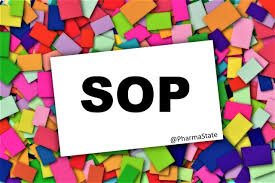SOP for Receipt and Maintenance of Working Standards of API .

Standard Operating Procedure (SOP)
1. Purpose
This SOP outlines the procedures for the receipt, storage, handling, and maintenance of working standards of Active Pharmaceutical Ingredients (API) to ensure the integrity, traceability, and appropriate usage for analytical purposes in the laboratory.
2. Scope
This procedure applies to all laboratory personnel involved in the receipt, storage, handling, and maintenance of working standards for API in [Organization/Department Name].
3. Definitions
-
Working Standard: A substance that is used in quantitative analytical procedures to establish the concentration of API in a sample. It is typically a less pure, but sufficiently accurate, standard for routine testing.
-
Primary Standard: A highly pure chemical substance used for the preparation of working standards.
4. Responsibilities
-
Laboratory Personnel: Responsible for the proper receipt, handling, and storage of working standards as per this SOP.
-
Quality Assurance (QA): Ensures that all working standards are received, stored, and maintained in compliance with regulatory requirements.
-
Supervisors/Managers: Ensure adherence to this SOP and conduct regular reviews of working standard maintenance practices.
-
Procurement/Receiving Department: Ensure that the working standards received are in compliance with the specifications and appropriately documented.
5. Materials and Equipment
-
Appropriate containers for standard storage (airtight, light-protected, etc.)
-
Analytical balance (calibrated)
-
Labeling materials (e.g., tags, pens)
-
Clean volumetric flasks or glassware
-
Desiccators for hygroscopic substances
-
Appropriate PPE (Personal Protective Equipment)
6. Procedure
6.1 Receipt of Working Standards
-
Upon receipt, inspect the shipping container for any signs of damage.
-
Ensure the shipment includes the Certificate of Analysis (CoA), and verify that the working standard matches the purchase order and is from an approved vendor.
-
Check the expiration date, storage conditions, and lot/batch number.
-
Perform visual inspection for any degradation, contamination, or moisture uptake (if hygroscopic).
-
Record the date of receipt, lot number, and supplier details in the laboratory inventory system.
-
Label the standard with the following information:
-
Name of the API
-
Lot number
-
Expiration date
-
Certificate of Analysis (CoA) reference number
-
Storage conditions (if any special conditions apply)
-
6.2 Storage of Working Standards
-
Store working standards in appropriate conditions as per the manufacturer’s specifications (e.g., temperature-controlled environments, dry places, protection from light).
-
For hygroscopic standards, store in a desiccator or sealed container to prevent moisture absorption.
-
Ensure that all containers are properly labeled with identification information (name, batch/lot number, storage conditions, etc.).
-
Maintain an inventory log to track the location, condition, and usage of working standards.
-
Perform regular inspections (e.g., quarterly) to ensure standards remain in good condition.
6.3 Handling and Use
-
Always use a clean, calibrated balance to weigh working standards.
-
Ensure that the working standard is properly labeled with the date of preparation and expiration once it has been opened or prepared for use.
-
If preparing solutions, ensure that the correct dilution and storage protocols are followed.
-
Avoid contamination of standards by using clean utensils and containers when handling the materials.
-
If not in use, store working standards in their original containers and conditions.
6.4 Maintenance of Working Standards
-
Regularly verify the stability of working standards by checking their appearance, weight, and physical properties (such as moisture content).
-
Conduct regular checks on the expiry dates and discard any working standards that have expired or are nearing expiration.
-
Update the inventory system to reflect the usage of working standards, ensuring that the remaining quantities are tracked.
-
For highly sensitive APIs, consider re-certifying the working standard annually or as per the manufacturer’s recommendation.
-
If a working standard is found to be contaminated, degraded, or otherwise unsuitable for use, it must be discarded following proper disposal procedures and a new standard must be obtained.
7. Documentation
-
Record all details related to the receipt, storage, and handling of working standards in the laboratory logbook or electronic inventory system.
-
Ensure that Certificates of Analysis (CoA) for each received working standard are filed and easily accessible.
-
Maintain a complete history of each working standard, including lot number, date received, expiration date, and usage records.
8. Precautions
-
Always use PPE (e.g., gloves, lab coat, goggles) when handling APIs.
-
Avoid cross-contamination by using clean, dedicated tools for each API standard.
-
For sensitive compounds, ensure the standards are handled in appropriate environments (e.g., controlled humidity, temperature).
-
Do not exceed the expiration date of the working standard without consulting the QA department.
-
Follow local and regulatory guidelines for the disposal of any expired or contaminated working standards.
9. References
-
Good Manufacturing Practices (GMP) for Pharmaceuticals
-
ICH (International Council for Harmonisation) Guidelines
-
USP (United States Pharmacopeia) or EP (European Pharmacopeia) guidelines for standardization
-
Internal Quality Manuals.
🎓 Discover one of the best Quality Assurance courses available — click below to explore the course that’s shaping future QA skills.

